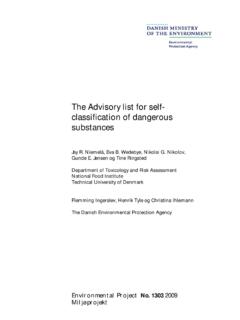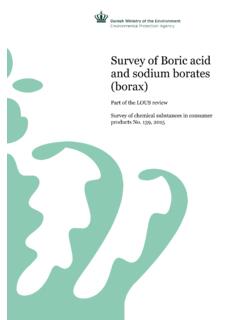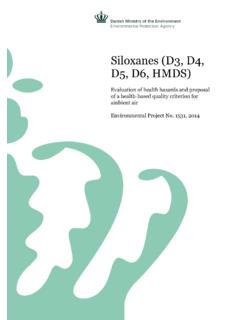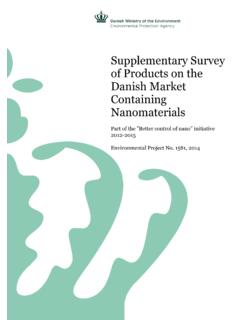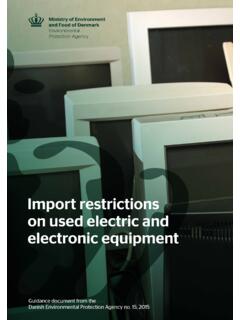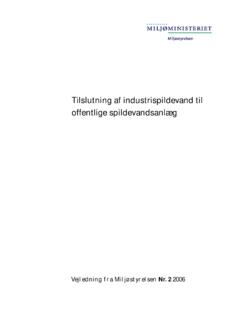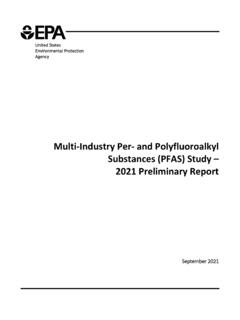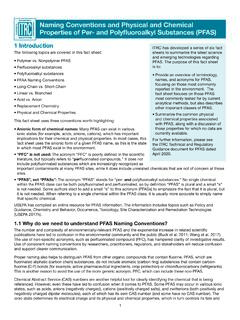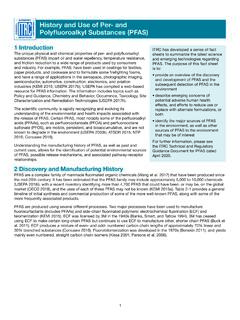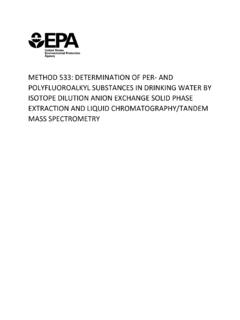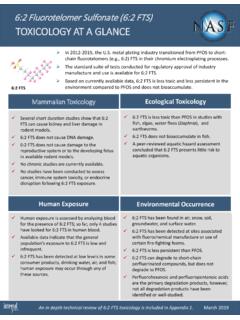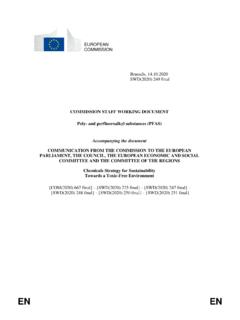Transcription of Short-chain Polyfluoroalkyl Substances (PFAS)
1 Short-chain Polyfluoroalkyl Substances ( pfas ). A literature review of information on human health effects and environmental fate and effect aspects of Short-chain pfas . Environmental project No. 1707, 2015. Title: Editing: Short-chain Polyfluoroalkyl Substances ( pfas ) Jesper Kj lholt 1. Allan Astrup Jensen 2. Marlies Warming 1. 1: COWI A/S. 2: NIPSECT. Published by: The Danish Environmental Protection Agency Strandgade 29. 1401 Copenhagen K. Denmark Year: ISBN no. 2015 978-87-93352-15-5. Disclaimer: When the occasion arises, the Danish Environmental Protection Agency will publish reports and papers concerning re- search and development projects within the environmental sector, financed by study grants provided by the Danish Envi- ronmental Protection Agency. It should be noted that such publications do not necessarily reflect the position or opinion of the Danish Environmental Protection Agency. However, publication does indicate that, in the opinion of the Danish Environmental Protection Agency, the content represents an important contribution to the debate surrounding Danish environmental policy.
2 Sources must be acknowledged. 2. Contents Preface .. 5. Summary and Conclusion .. 7. Sammendrag og konklusion .. 11. 1. Introduction .. 15. Background and scope .. 15. Objective .. 15. 2. Chemistry and uses .. 17. Background about polyfluoroalkylated Substances ( pfas ) .. 17. Short-chain alternatives to C8-polyfluoroalkylated Substances ..18. Developments in industry .. 20. Recent uses of Short-chain alternatives .. 21. Impregnation .. 21. Fire-fighting 21. Metal plating .. 21. Oil production .. 21. Food packaging .. 21. Substances included in this study .. 22. 3. Human health effects .. 23. General aspects of toxicokinetics and metabolism .. 23. Uptake and distribution .. 23. Levels in human blood .. 24. Metabolism/biotransformation .. 26. Excretion/elimination from the body .. 27. Blood serum elimination half-lives .. 27. Fetal and lactational transfer .. 28. Toxicological mechanisms .. 28. Peroxisome proliferation.
3 28. Effects on cell membranes .. 29. Effect on 29. Cytotoxicity .. 29. Neurotoxicity .. 30. Endocrine disruption .. 30. Toxic effects of single pfas .. 30. Perfluoroalkane sulfonic acids/sulfonates (PFSA) .. 31. Perfluoroalkanoic acids/perfluoroalkanoates, perfluorocarboxylic acid/perfluorocarboxylates (PFCA).. 36. Perfluoroalkyl halogenides .. 39. Perfluoroalkyl phosphor compounds .. 39. Fluorotelomers and derivatives .. 40. Occurrence and exposure in relation to humans .. 45. Occurrence in products .. 45. pfas in indoor air and workplace air .. 46. 4. Environmental fate and effects ..49. Environmental behaviour and fate .. 49. Physico-chemical properties of environmental relevance .. 49. Abiotic transformation and 50. Biotransformation and degradation .. 50. Bioaccumulation .. 51. Sorption, mobility and distribution .. 51. Long-range atmospheric and marine transport .. 52. Environmental effects.
4 52. Toxicity to aquatic organisms .. 53. Toxicity to terrestrial 59. Environmental fate and effects of single pfas ..61. Perfluoroalkane sulfonic acids/sulfonates (PFSA) ..61. Perfluoroalkanoic acids/perfluoroalkanoates, perfluorocarboxylic acids and perfluorocarboxylates (PFCA) .. 62. Perfluoroalkyl halogenides .. 63. Perfluoroalkyl phosphor compounds .. 63. Fluorotelomers .. 63. PBT 64. Environmental occurrence and exposure .. 65. Aquatic environment .. 65. Terrestrial environment .. 70. Biota .. 71. Atmospheric environment .. 73. 5. Summary and conclusions .. 75. Human health effects and exposure ..75. Human health effects ..75. Exposure of humans .. 76. Environmental fate and effects .. 76. Environmental fate .. 76. Environmental effects ..77. Environmental occurrence and exposure ..77. Short-chain pfas as alternatives to PFOS/PFOA .. 78. Human health 78. Environmental 78. Data gaps .. 79. Human health effects (including exposure).
5 79. Environmental aspects (including exposure) .. 79. Abbreviations and acronyms .. 81. References ..85. Appendix 1: List of Substances considered to be " Short-chain pfas " .. 97. 4. Preface A survey of PFOS, PFOA and other perfluoroalkyl and Polyfluoroalkyl Substances (here collectively referred to as pfas ) were undertaken in 2012 as part of the surveys of the Danish EPA of the 40 Substances / substance groups on the Agency's List of Undesirable Substances (LOUS). On the basis of the survey, the Danish EPA developed three strategy papers (Danish EPA, 2013) addressing the following issues: risk management of PFOS and PFOS Substances ;. risk management of PFOA and PFOA Substances ; and risk management of other perfluorinated Substances . The strategy papers note that there is a general lack of published data on the properties of the alternatives to the pfas of most concern, partly because the data usually are protected by trade secrets, partly because most of the scientific research have focused on a few polyfluorinated Substances such as PFOS and PFOA; historically the Substances of most concern.
6 In order to obtain further information on alternatives to the pfas of most concern and to pfas in general, the Danish EPA have launched two reviews: This literature review of environmental and health properties of Short-chain pfas ;. A study on non-fluorinated alternatives to pfas -based impregnation agents for textiles. The objective of this study is: To provided an updated overview of the human health and environmental fate and effects aspects of short - chain polyfluorinated Substances introduced as alternatives to PFOS/PFOA and other long- chain pfas ;. To support the Danish EPA's strategy on this substance group by providing background documentation in relation to further activities, including possible regulation. The project has been carried out by COWI A/S with NIPSECT as subcontractor in the period July-December 2014. and was followed by a steering group consisting of: Louise Grave-Larsen, Danish Environmental Protection Agency Jesper Kj lholt, COWI A/S.
7 Allan Astrup Jensen, NIPSECT. 5. 6. Summary and Conclusion This report has been prepared to support part of the Danish EPA's strategy on other perfluorinated Substances . ( other than PFOS and PFOA). In the strategy it is, among others, stated that an overview of uses and applica- tions, exposure and impact on human health and the environment should be established, and a need for more information on Short-chain pfas as possible alternatives to the long-chained was identified. Hence, the objectives of this study have been to review the open literature on these subjects for Short-chain pfas . and assess the possible impacts of these Substances on human health and the environment in comparison to long- chain pfas and thereby supporting the Danish EPA's strategy on this substance group by providing background documentation in relation to further activities, including possible regulation. Chemistry and uses of Short-chain pfas .
8 The most important Short-chain perfluoroalkyl sulfonic acids are perfluorobutane sulfonic acid (C4, PFBS) and perfluorohexane sulfonic acid (C6, PFHxS), which also exist as various salts. The only difference to PFOS is the four, respectively two, fluorocarbon shorter perfluorinated chain ( tail ). Similarly to PFOS the Short-chain alter- natives have hundreds of precursors such as the more complex molecules N-Methyl perfluorobutane sulfon- amidoethanol (MeFBSE) and N-methyl perfluorohexane sulfonamidoethyl acrylate. The most important Short-chain alternatives among the perfluorocarboxylic acids (PFCAs), are perfluorobutanoic acid (PFBA) and perfluorohexanoic acid (PFHxA) and their precursors: the Short-chain fluorotelomers such as 4:2. FTOH and 6:2 FTOH, and as for the C8- pfas , there are hundreds of derivatives in use, for instance, phosphates and acrylates. The Short-chain pfas , especially the C6- Substances such as 6:2 fluorotelomers, are used to about the same appli- cations (impregnation, metal plating, fire-fighting foams, food packaging etc.)
9 As the C8-analogues; however, the C8 has optimal surfactant properties with very low surface tensions and therefore may be the preferable substanc- es from a technological point of view. Human health effects and exposure It is known from animal studies that the studied short chain polyfluoroalkylated Substances ( pfas ) are almost completely absorbed orally and by inhalation but that skin absorption may be negligible. Both short - and long- chain perfluoroalkyl acids (PFAAs) are considered being metabolically inert. The strong C-F bonds exclude any normal degradation pathway. Any functional derivative (precursor) will through several steps ultimately be trans- formed to the acids. That is also the case for fluorotelomers and derivatives hereof, which are biotransformed into PFCAs of different chain length through several metabolic steps, including aldehydes and saturated and unsatu- rated carboxylic acids.
10 These metabolites are more toxic than the parent compounds, and one of these metabo- lites: perfluorohexyl ethanoic acid (FHEA) was measured in various tissues from deceased people. The mean blood elimination half-lives for PFAAs depend on the chemical substance and animal species and its sex. Generally, the blood half-lives of PFAAs are longer for sulfonates than for carboxylates, half-lives increase with chain length for carboxylates, and are shorter for branched isomers, and in animals they are often shorter in females due to the sex hormone dependent difference in renal clearance. Further, the serum half-lives of PFAAs are dose-dependent with longer half-lives for the lower concentrations relevant for humans. The general blood elimination half-lives of PFAAs in exposed rodents were hours or few days, in monkeys a little longer and in hu- mans much longer and often years. The blood elimination half-lives of PFAAs decrease generally with shorter chain length.
